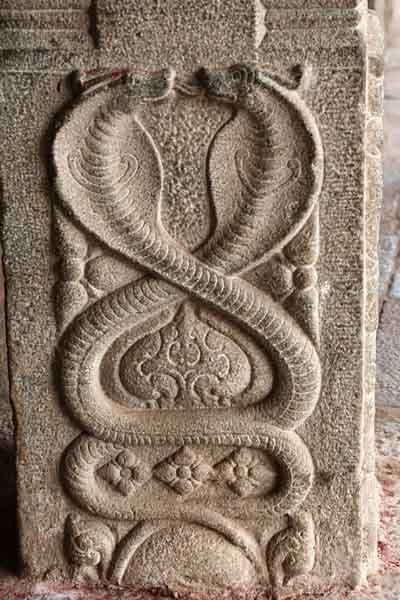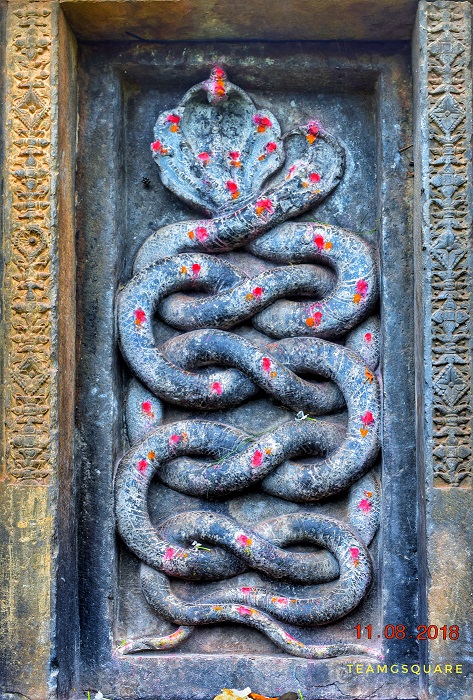Naga-Nagini (Serpent Deities) entwined on the walls of the 12th-century Kamala Narayana Temple in Kadamba, India, circa 1174 A.D.

The Naga-Nagini (entangled snakes) carvings on the walls of the Kamala Narayana Temple are a mesmerizing example of the artistic and spiritual heritage of the 12th-century Kadamba era in India. This temple, located in Degaon, Karnataka, was constructed in 1174 A.D. and stands as a testament to the architectural and cultural achievements of the Kadamba dynasty. The intricate depictions of Naga and Nagini, serpentine deities entwined together, are particularly significant and captivating features of this historic monument.
The Kamala Narayana Temple, dedicated to Lord Vishnu, exemplifies the distinctive Kadamba style of architecture. The temple is adorned with detailed carvings and sculptures that narrate various mythological stories and spiritual themes. Among these, the Naga-Nagini carvings are especially notable for their elaborate design and symbolic meanings. These carvings typically depict serpents intertwined in a harmonious embrace, representing the duality and unity of male and female energies, as well as the cycle of life, death, and rebirth.

In Hindu mythology, Nagas are considered powerful and revered beings, often associated with water bodies, fertility, and protection. The entwined form of Naga and Nagini on the temple walls is not only a decorative element but also a symbolic representation of divine forces. These deities are believed to possess immense strength and wisdom, and their presence in the temple signifies protection and blessings for the devotees. The depiction of entangled snakes also conveys a sense of balance and harmony, reflecting the interconnectedness of all life forms.
The craftsmanship displayed in the Naga-Nagini carvings is remarkable, showcasing the skill and creativity of the artisans of the Kadamba era. Each scale of the serpents is meticulously detailed, and the fluidity of their entwined bodies is rendered with exceptional finesse. The artisans’ ability to infuse life into stone through such intricate carvings is a testament to their mastery and dedication. These artistic creations not only enhance the aesthetic appeal of the temple but also serve as a medium for conveying profound spiritual messages.
Visitors to the Kamala Narayana Temple are often struck by the beauty and intricacy of the Naga-Nagini carvings. The serpentine figures, with their graceful curves and intricate patterns, create a sense of movement and vitality on the temple walls. The interplay of light and shadow on these carvings further accentuates their three-dimensional quality, making them appear almost lifelike. This artistic brilliance draws visitors into a deeper contemplation of the spiritual and cultural significance of the temple.

The Naga-Nagini carvings also highlight the rich cultural exchange and syncretism that characterized the Kadamba era. The depiction of serpentine deities is a motif that resonates with various cultural and religious traditions in India, reflecting the inclusive and diverse nature of the society at that time. The integration of such motifs into the temple’s design illustrates the harmonious coexistence of different beliefs and practices, enriching the cultural tapestry of the region.
In conclusion, the Naga-Nagini carvings on the walls of the 12th-century Kadamba era Kamala Narayana Temple in India are a profound example of the artistic and spiritual heritage of that period. These intricate depictions of entwined serpents not only enhance the temple’s aesthetic beauty but also embody deep symbolic meanings related to protection, fertility, and the cycle of life. The exceptional craftsmanship of the artisans and the rich cultural significance of these carvings continue to captivate and inspire visitors, offering a glimpse into the remarkable legacy of the Kadamba dynasty.